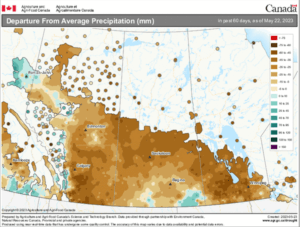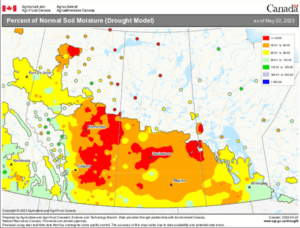CROP PROGRESS REPORT – MAY 24, 2023
Seeding in western Canada started late this year due to a cold and delayed spring. However, good progress has been made in recent weeks as dry, warm conditions allowed for most regions to catch up, and there is little risk as to whether the barley crop will get planted in a timely manner.
Of greater concern is the dryness through a good portion of the western Prairie growing area. Aside from southeast and parts of south-central Saskatchewan, western Canada has seen well below normal precipitation this spring. Some of the driest western regions have recently received beneficial rain, and there is more in the forecast, although additional moisture will be needed in the coming weeks given the current deficits and expectations for high temperatures going forward.

Spring rain has also been below average through much of western Canada, as shown in the departure from average precipitation over the past 60 days.
The eastern half of western Canada came into the growing season in a better moisture situation, so the lack of rain is not yet as concerning as in the western half of the Prairies, particularly central Alberta and west central Saskatchewan. This has resulted in the percent of normal soil moisture being somewhat less threatening in eastern Manitoba and portions of the very southern regions of Saskatchewan and Alberta near the US border as of mid-May. Whether or not the rain materializes as forecast for the driest areas could impact the early season outlook for yield potential, particularly given the forecast for high temperatures later in the week.

A good portion of central Alberta and the northern half of Saskatchewan are showing below normal soil moisture conditions. Some rain in the forecast may help improve soil moisture, although likely not enough alleviate the deficit.
There have been a few reports of fertilizer shortages impacting seeding progress in some areas. This seems to be more local and regional due to logistical and specific supply chain challenges, rather than a widespread problem across western Canada, but requires close monitoring nonetheless.
|
|
|
|


